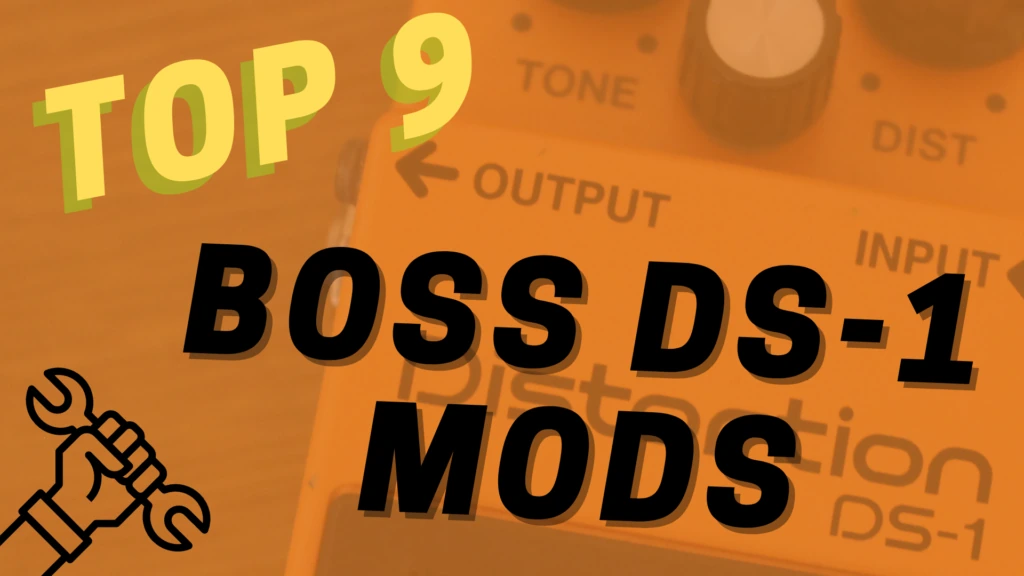
The BOSS DS-1 distortion has been with us for almost half a century. The DS-1 is a distortion pedal with a relatively simple circuit and has been popularized by the likes of Kurt Cobain, Joe Satriani, Robert Smith, Steve Vai, and others.
Most iterations of the DS-1 have been built with through-hole electrical components, making the act of modifying the circuit extremely easy. Here are just some of the top BOSS DS-1 modifications.
As a member of the Reverb Partner Program and as an Amazon Associate, StompboxElectronics earns from, and is supported by, qualifying purchases.
Disclaimer: Stompbox Electronics and/or the author of this article is/are not responsible for any mishaps that occur as a result of applying this content.
1. Robert Keeley’s Baseline, Ultra, and Seeing Eye Mods
This modification was found in DIY Stompboxes’ Build Your Own DS-1 Distortion document. It originated on Robert Keeley’s site and involves swapping 11 capacitors and 3 resistors.
One 47pF capacitor is also added across the clipping diodes D4 and D5.
| Component | New Value |
|---|---|
| C1, C3, C5, C12, C13 | 0.1μF metal film cap |
| C2, C8, C9, C14 | 1μF metal film cap |
| C11 | 0.047μF metal film cap |
| C7 | 220pF mica cap |
| R13 | 2.4kΩ metal film resistor |
| R39 | 20kΩ metal film resistor |
| R14 | 1.5kΩ metal film resistor |
Ultra Mod
For the Ultra Mod, the D4 diode is substituted by a two-way SPDT toggle switch network. This mod calls for the following parts:
- SPDT Toggle Switch (Qty. 1)
- 1N4148 Diodes (Qty. 2)
- 3mm Red LED (Qty. 1)
Remove the existing D4 diode. Connect the common (middle) lug of the toggle switch to where the cathode of D4 was connected. The toggle switch alternates between (1) a ‘stock’ setting with one of the 1N4148 diodes, and (2) the red LED in series with a 1N4148 diode.
The idea behind this modification is to introduce asymmetry to the distortion circuit’s clipping behavior. The branch with the 1N4148 and red LED has more headroom than the branch with just the 1N4148.
Seeing Eye Mod
The Seeing Eye mod introduces another SPDT toggle switch to the clipping circuit. This time, remove the D5 diode. Attach the common (middle) lug of the switch to where the cathode of the D5 diode was connected. One direction of the toggle should connect a 1N4148 in parallel with D4. The other direction connects the 3mm red LED.
Leaving Out the Toggle Switches
Note that if you don’t care about keeping the stock settings, you can simply leave out the toggle switches. Just replace D4 with a 1N4148 + 3mm red LED branch (Ultra Mod), and replace D5 with a 3mm red LED (Seeing Eye Mod).
2. JHS Synth Drive Mod

Recently JHS discontinued all modifications, one of which being the Synth Drive Mod for the DS-1. This mod replaces 8 capacitors, 1 resistor, and 2 diodes.
| Component | New Value |
|---|---|
| C1, C5, C13 | 0.1uF cap |
| C2, C8, C14 | 1uF cap (non-polarized) |
| C3, C11 | 0.047uF cap |
| R35 | 1.1k metal film resistor |
| D4 | 1N4001 rectification diode |
| D5 | 2x 5mm red LEDs in series |
In the original mod, one of the two red LEDs is mounted in a bezel on the front face of the pedal. This makes for an awesome-looking display because as you play the light from the LED flickers in response to the signal clipping.
There are three SPST switches used in this mod mounted to the sides of the enclosure. Thanks to rousejeremy from DIYStompboxes, here is how they are connected:
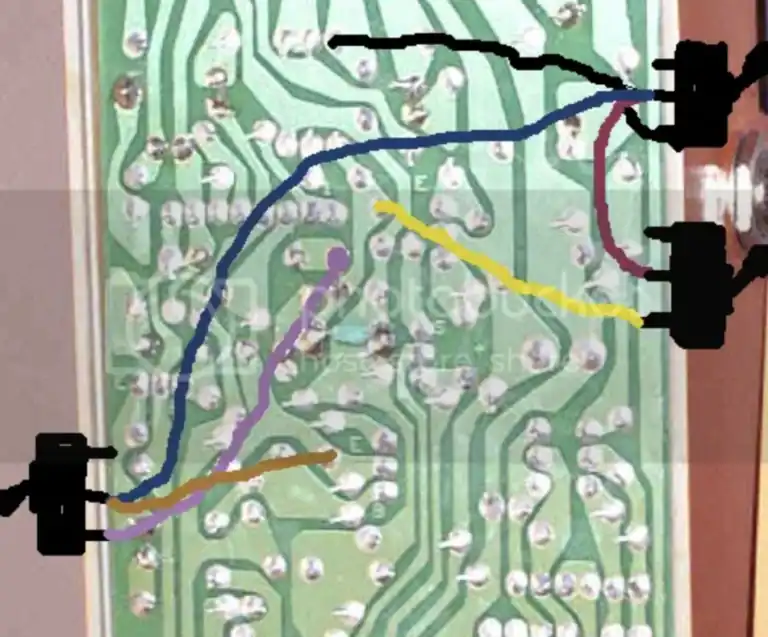
3. Mimmotronics’ PsyOp Modification
Here is a Mimmotronics original for the BOSS DS-1, called the PsyOp mod. It involves two toggle switches: one to alternate between two (2) diode clipping arrangements and another to toggle between three (3) capacitance values to shape the tone.
The display is similar to JHS’ Synth Mod but uses a green LED instead of a red LED. This is because the Forward Voltage drop range for green LEDs is generally higher than that of red LEDs, which provides for a softer clipping profile and a more transparent overdrive sound.
4. Mimmotronics’ Outsource Mod
An Outsource Mod is a mod where the pedal is engaged/disengaged via an external switch. BOSS compact pedals operate with momentary contacts. Hypothetically, if you were to connect 2 or more of these momentary contacts in parallel, you would be able to turn more than one BOSS pedal on at the same time.
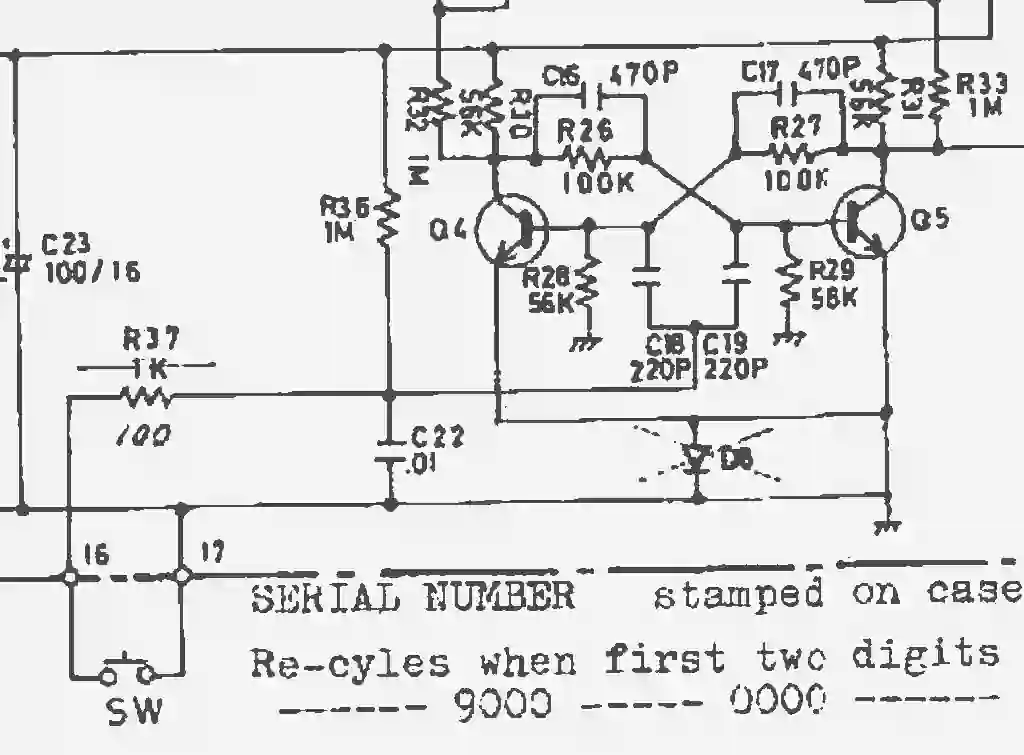
The Outsource mod for the BOSS DS-1 involves installing a 3.5mm jack to the side of the pedal. Connect the tip of the jack to the side of the switch connected to number 16 in the schematic above. Connect the sleeve of the jack to the common (#17).
Performing this mod on another BOSS compact pedal will allow you to connect together the two pedals with a 3.5mm cord and turn them both ON and OFF simultaneously. If you want to have the option to return the pedal to its stock operation, you can interrupt the connection by installing an SPST toggle switch.
5. Wampler’s Less Shrill Highs Mod
In my opinion, the BOSS DS-1 has a shrilly high end in the upper distortion settings. Brian Wampler in his book How to Modify Guitar Pedals lists a modification for making the highs a little more bearable. Simply replace the stock C10 capacitor (0.01uF) with a larger value to lower the cut-off frequency.
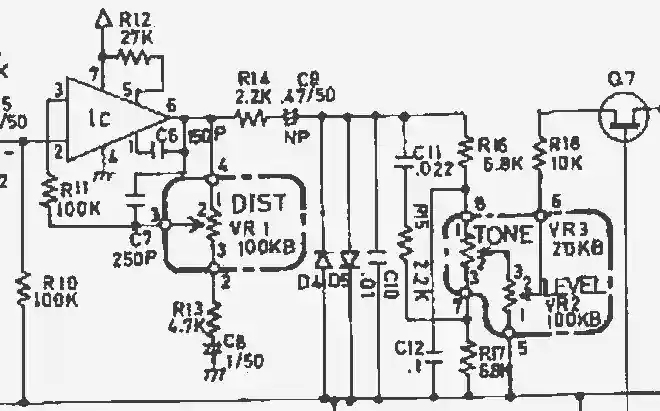
Normally this frequency cut-off is very high, but with lower capacitance values (between 0.022uF and 0.047uF) you can roll over the highs substantially.
6. ACA to PSA Conversion Mod
Some users of older BOSS compact-style pedals have problems with ‘normal’ 9Vdc power supplies. The reason is that early compact models had a diode and resistor between the ring connection of the input jack and the center lug of the ac adapter plug.
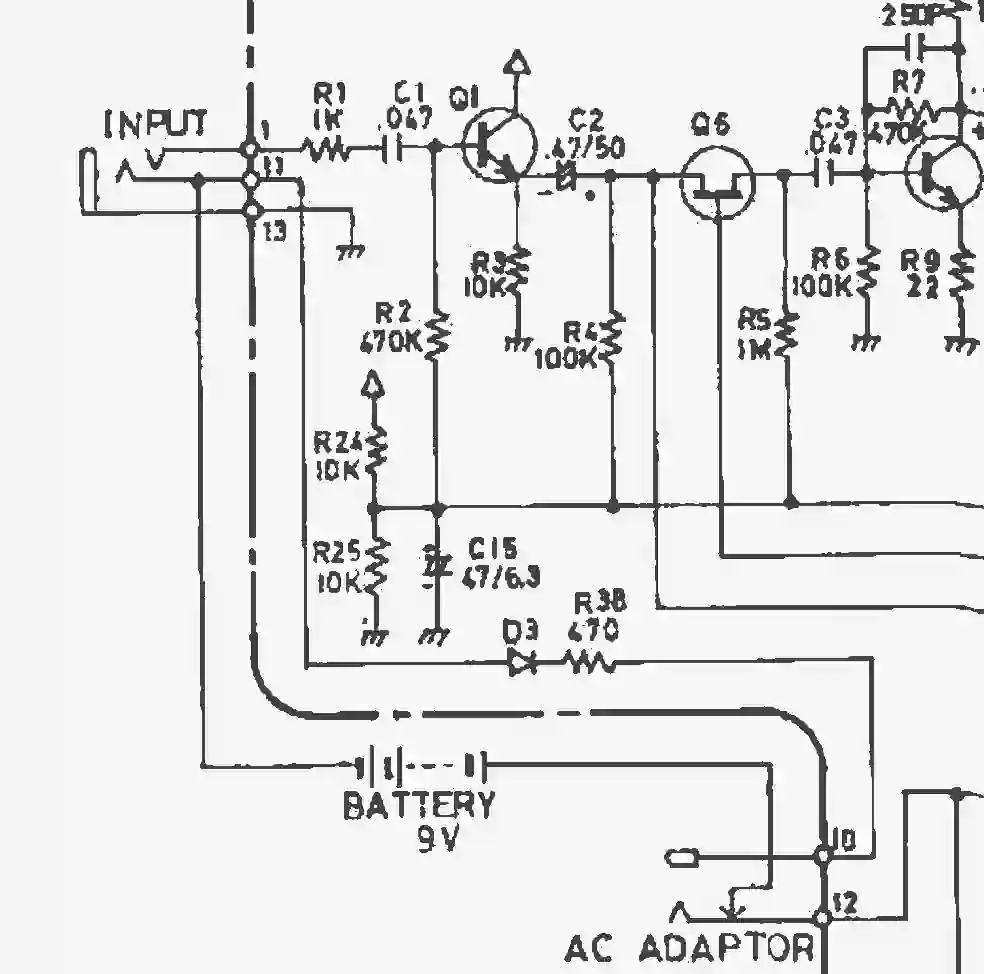
These components allowed the use of 12Vdc ACA-style power supplies. These days ACA is not used, making these components useless of you’re using a newer power supply. You can modify the DS-1 by replacing D3 and R38 with simple jumper wire. Read more about modifying your BOSS pedal from ACA to PSA.
7. Monte Allums Roxx Tri-Gain Plus Mod
There has been tons of buzz around ‘stacking’ op amps to obtain a more tube-like sound in distortion circuits. The DS-1 has been a major guinea pig in this debate, and Monte Allums has developed a modification that surrounds this approach: The Tri-Gain Plus Mod.
The mod uses two NE5532 op amps, affixed to a custom retrofit board and inserted into the signature 8-pin single in-line (SIL) IC slot. It comes as a kit, complete with cap replacements, diode configuration replacements, wires, a toggle switch, and desoldering braid.
Unfortunately, BOSS has changed the DS-1 circuit multiple times throughout its lengthy history. Any DS-1s built past 2016 utilize surface-mount components and are therefore not mod-able. According to Monte Allums, that excludes the black 40th anniversary DS-1 from 2018. The new DS-1W Waza Craft pedals released in 2022 also use surface mount components and are not mod-able.
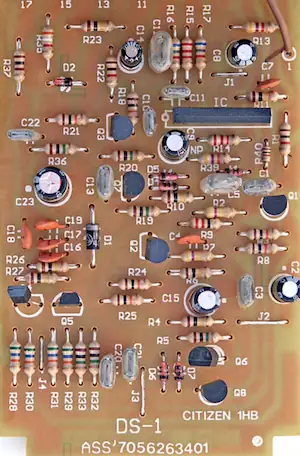
Additionally, the SIL chip used in vintage DS-1 builds is not compatible with the retrofit board in the mod. If you decide to perform the Roxx mod, make certain you have the version above.
Check whether your DS-1 is compatible using the BOSS pedal serial number decoder. Just type in the serial number and it should tell you the year it was manufactured.
8. Jack Orman’s Fat Mod
This mod is super simple and comes from a May 2008 article from AMZ-FX written by Jack Orman. It involves replacing two resistors in the preamp section of the circuit with the aim of lowering the gain, offering better control over the distortion level.
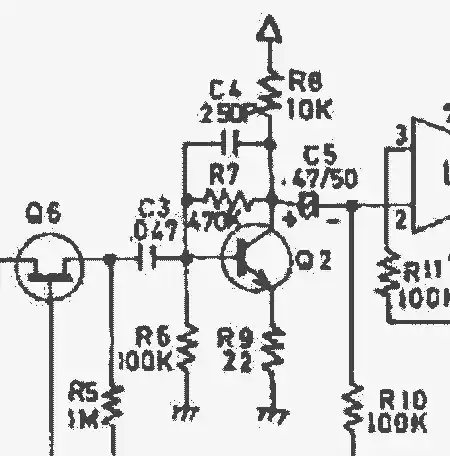
Increasing R9 has the effect of decreasing the overall gain from the preamp section. This has a secondary effect on the biasing of the transistor, which is dealt with by replacing R6.
| Component | New Value |
|---|---|
| R6 | 150k resistor |
| R9 | 1k resistor |
I wrote an article completely dedicated to the Fat Mod where you can find the details of what it does, as well as audio samples for how it sounds.
9. Blend Crossover Mods
Speaking of Jack Orman, in a 2007 article he outlined many approaches for diode clipping controls. One of which is an inspiration for a modification called the Mondo-MIJ mod shown in the DIYStompboxes document (see #1).
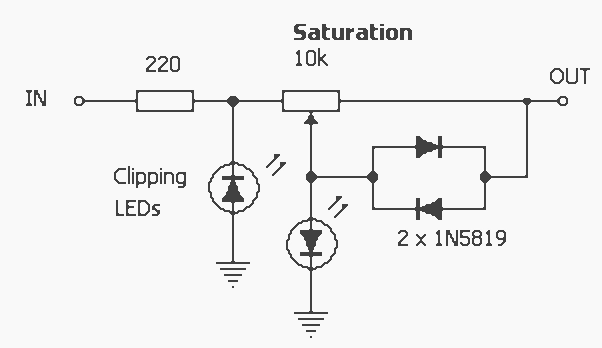
In my experience, adding a blend control is never a bad thing. The configurations in Orman’s article allow you to think about introducing a blend control to the DS-1’s clipping circuit.
Meet the Author:

Hi, I’m Dominic. By day, I’m an engineer. By night, I repair and modify guitar effects! Since 2017, I’ve been independently modifying and repairing guitar effects and audio equipment under Mimmotronics Effects in Western New York. After coming out with a series of guitar effects development boards, I decided the next step is to support that community through content on what I’ve learned through the years. Writing about electronics gives me great joy, particularly because I love seeing what others do with the knowledge they gain about guitar effects and audio circuits. Feel free to reach out using the contact form!
The Tools I Use
As a member of Amazon Associates, Stompbox Electronics earns and is supported by qualifying purchases.













